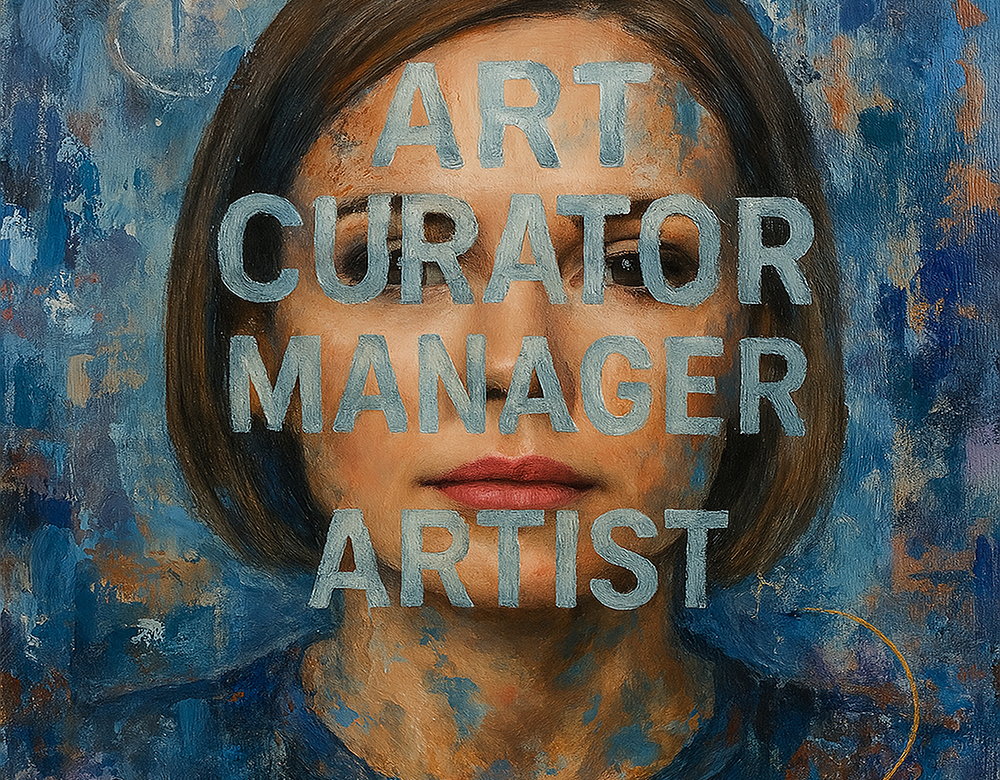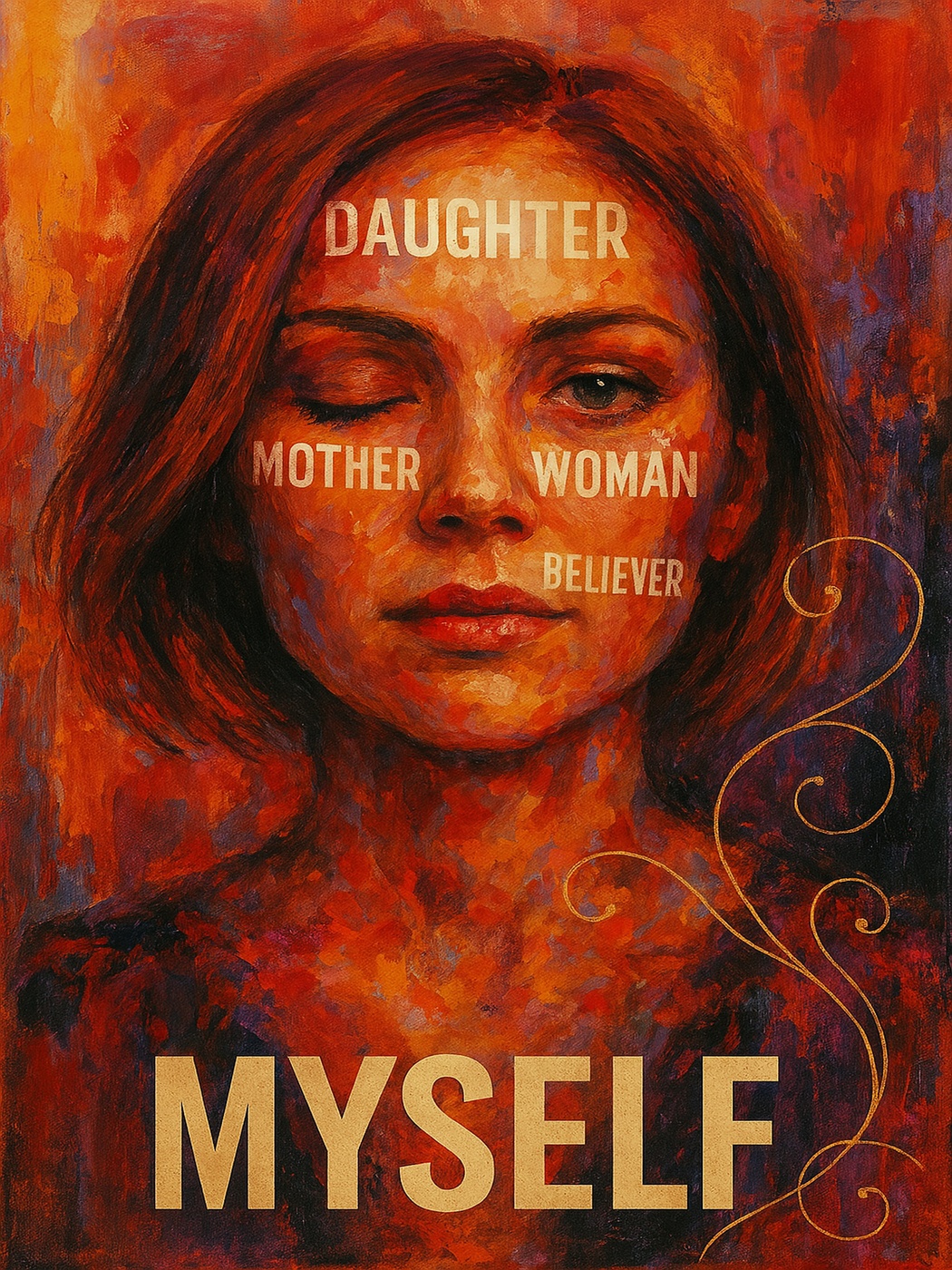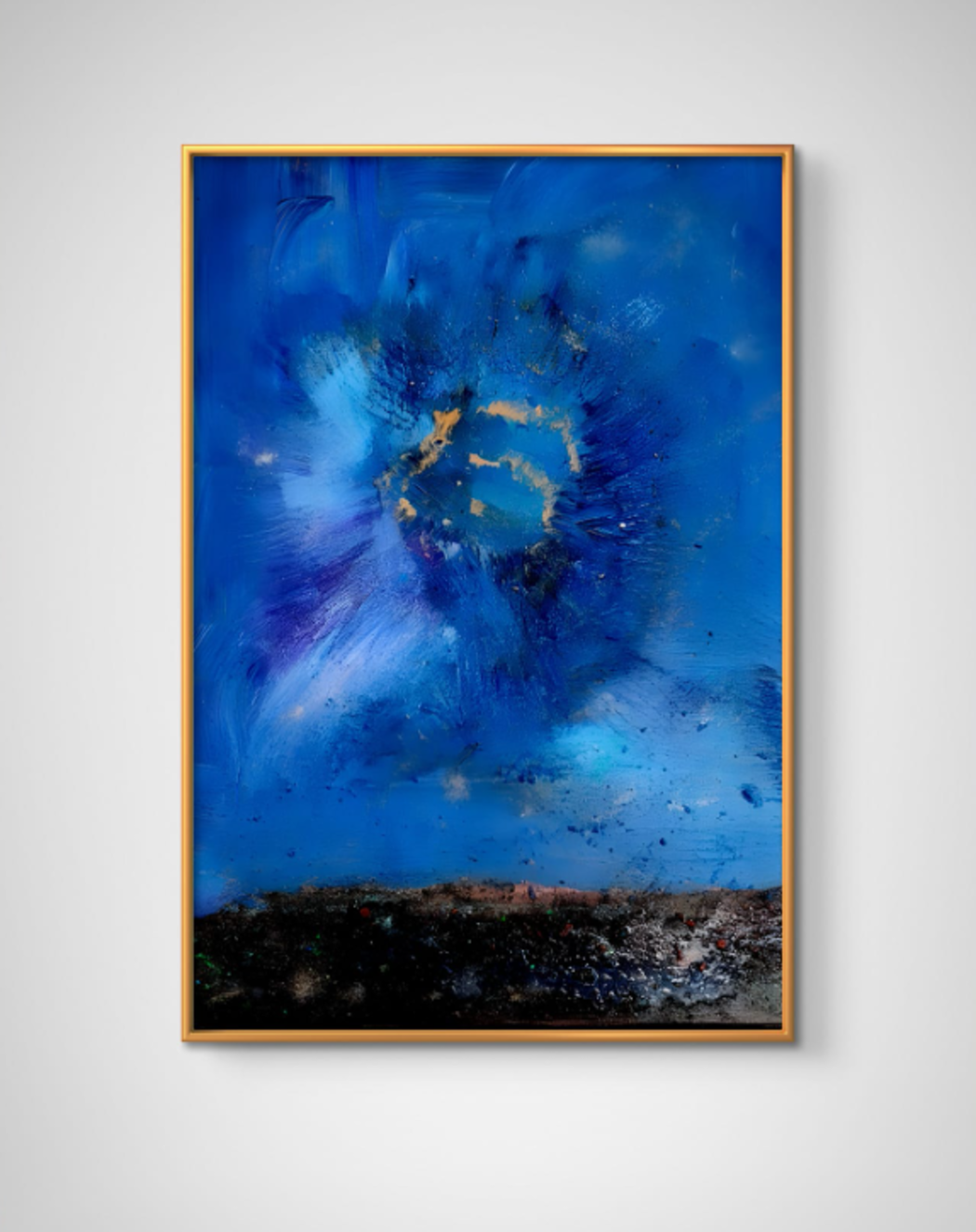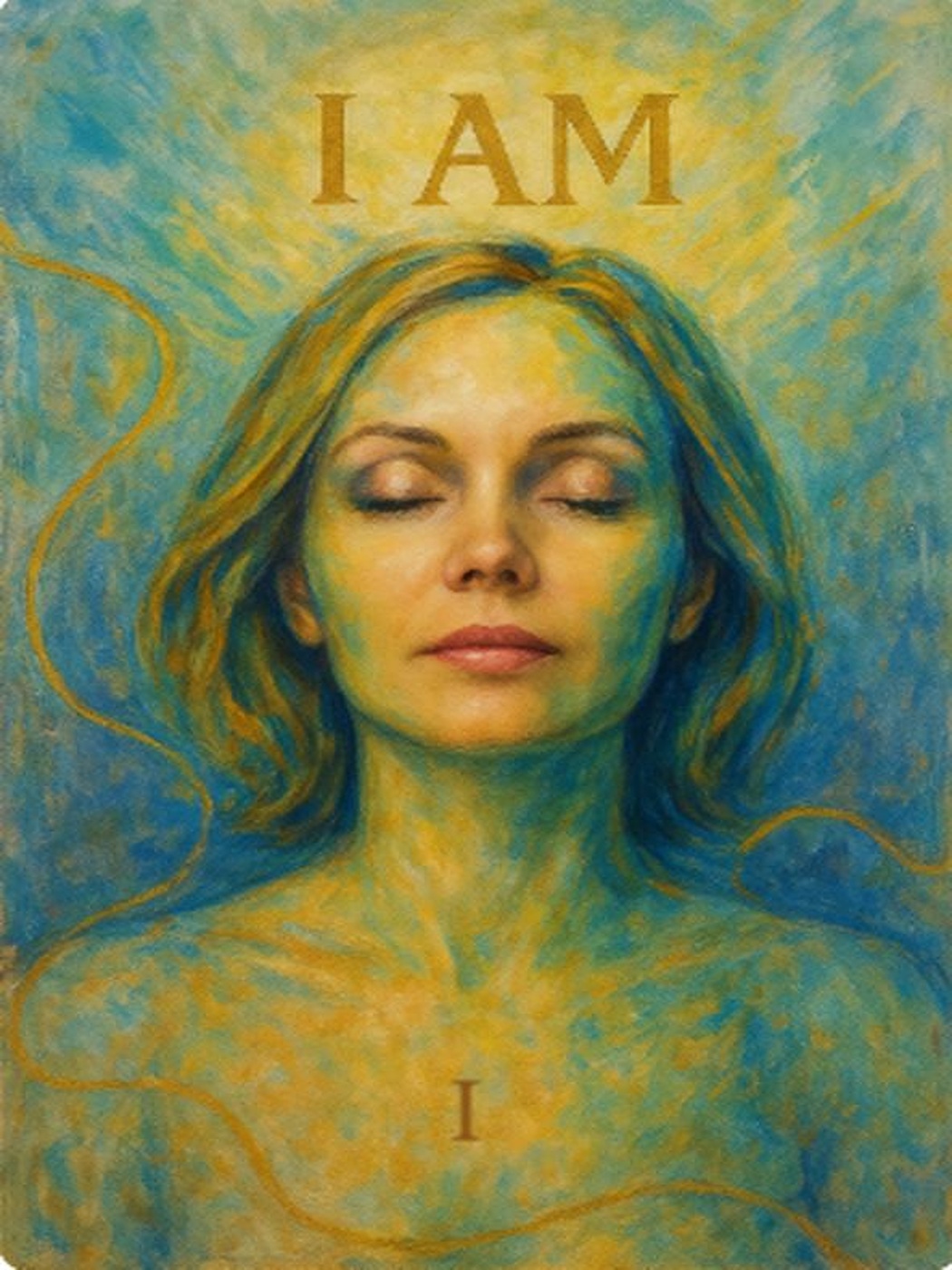Patrycja Joanna Sikorska
Year of birth: 1975
Place of residence: Warsaw, Poland
Education:
Cultural Studies (in progres); participant in the NODE Center International Curatorial Program (Berlin);
volunteer artist-in-residence at the Museum of Modern Art in Warsaw;
Art Curator at the International Socio-Cultural Institute Foundation.
Three words describing her art: Introspective. Textural. Spiritual.
Disciplines: Painting and mixed media using natural materials; digital art.
 Patrycja Joanna Sikorska | ME | 2025
Patrycja Joanna Sikorska | ME | 2025
Your project “Me, Myself, and I” explores complex aspects of identity. What inspired you to combine traditional painting with AI in this intimate self-exploration?
This project emerged at the intersection of introspection and innovation. The triptych was created in collaboration with AI—as a form of dialogue between technology and intuition. I stood before myself with the question: Who am I—beneath the layers of professional or social roles, beneath the memories and dreams I carry within, in the silence of being without action? How to define these layers? And then I felt that it’s Me, Myself, and I; each layer is a different element of life, yet all are me.
Painting is one of my soul’s languages, but this time I felt the need to extend it and invite another, digital “consciousness” into the conversation to become my “companion.” It wasn’t a process of writing a technical prompt but a long ‘conversation’ that organically formed a prompt serving as the basis for creating each image. There were many proposed images for each of these three areas. When the result didn’t feel satisfactory, I added new translational layers to our conversation, and we made adjustments until the essence of the message and form felt achieved.
It was a dance between logic and intuition, where the virtual brush followed the heartbeat and intuition of the soul. I continue to explore this collaboration in my next artistic project. It brings me joy that these digital images are the result of a specific conversation; looking at them, I see the entire internal process leading to this outcome.
By combining tradition with technology, I ultimately presented different roles of a single identity, embodying their fragmentation, fluidity, and simultaneity. I wanted to invite viewers to ask themselves the same multilayered question: Who am I now? And find their own answer. Everyone can create their own image in this way and name their layers, just as I did.
I feel that answering this question is immensely important in today’s world. It’s essentially a question of whether I am in a given role because I choose to be. If so, am I satisfied with who I am in this area of my life? Or do I want to change something in my way of being or expression? Am I in a given role by chance? And if by chance, do I feel good about it, or do I still want to be in it? It’s essentially a question of how I shape myself and my daily reality. Do I maintain balance in it? Am I courageous? Do I truly express myself? Am I fulfilled? Do I feel that I am following my individual path? What do I give, what do I receive, what do I create, and what will I leave behind?
In your work, you use raw, organic materials—clay, charcoal, powdered crystals. How do they influence the emotional reception of your pieces?
Each material carries a story older than myself. Clay remembers touch. Charcoal holds the spirit of fire. Crystals pulse with silent frequencies—invisible but perceptible. These aren’t just materials—they are witnesses to processes occurring beneath the surface.
When I mix them with paint, I invite the Earth itself to co-create the image. This imparts a certain sanctity to the work. It slows me down. It reminds me that creation isn’t sterile or smooth—it’s tactile, unpredictable, intimate. Viewers may not always notice the clay, but they’ll feel its weight. Charcoal doesn’t shout but leaves a whisper. Crystals aren’t large, yet their presence is unmistakable because they subtly shimmer. On an energetic level, such a painting has entirely different vibrations.
Through structure and substance, the painting begins to breathe—not only through what it depicts but through how it feels to be—touched, cracked, reassembled, connected, coexisting, blended.
 Patrycja Joanna Sikorska | MYSELF | 2025
Patrycja Joanna Sikorska | MYSELF | 2025
You describe your art as a spiritual act. How does the creative process become a spiritual practice for you, and what role does intuition play in it?
When I paint, my goal isn’t to decorate. My aim is to be within myself, here and now, and express what I carry in my space. What I carry depends on my choices regarding whom and what I interact with and what that evokes in me. The act itself is a meditation, almost a ritual. A return to silence, to the Source, to a language before words. In this space, my hands know what the mind has forgotten.
Intuition is my compass. It doesn’t scream—it suggests, hums, knows when to pause. Sometimes it tells me to paint over a face I just finished. Sometimes it suggests gold amidst gray. I follow myself.
In this process, there’s a force that seems beyond me, yet it’s within me. I don’t always understand what I’m creating until it’s finished. And even then, the painting continues to reveal itself, to each viewer in their own way. It’s the viewer who decides what they see, and that’s a characteristic feature of my painting—it converses with everyone in their own language. It’s like an externalized self, a spiritual layer dressed in matter to enter into a specific interaction with others.
All my paintings have found new owners; unfortunately, I didn’t have the habit of photographing them, except for one painting presented here, which has long filled the office space of a Warsaw company.
Themes of roles and masks are central in your project. How do you visually represent these psychological layers through composition, symbolism, and the use of words?
Roles are costumes we wear so long that we forget we’re playing them. In this forgetfulness, or rather automatism, lies a certain danger—we stop reflecting, developing, and even cease to be creators of ourselves and our lives, becoming mere performers. In “Me, Myself, and I”, I wanted to showcase them. I used words directly on the face because these roles also reflect how others see us. I presented them boldly, almost confrontationally, e.g., Artist. Curator. Manager. In this image, they don’t whisper—they define, on one hand opening me up, on the other limiting me, because that’s how roles operate.
Each face in the triptych represents a different truth. Each layer – a different relationship with the self and the world.
ME – Social image
Role. Construction. Artificial calm.
A face hidden behind the words: art curator, manager, artist.
Visible, yet trapped in labels.
A symbol of what I represent – not necessarily who I am inside.
MYSELF – Personal roles and relationships
Closeness. Tenderness. Emotional identity.
A partially revealed face, surrounded by the words: daughter, mother, woman, believer, friend.
Unclear, dynamic, full of tangled emotional bonds.
I – The pure soul
Source. Awareness. Presence.
A full face, radiating with light.
No words. No symbols.
Just one expression: I AM.
Nothing more is needed.
“I” completely abandons the need for a mask. It radiates. No words on the skin—only affirmation above it: I AM.
In terms of composition, the faces shift in tone and presence—first the social image, then emotional identity, and finally pure existence. The golden line that connects all three layers represents the continuum of the soul—unchanging despite the transformations of the persona.
 Patrycja Joanna Sikorska | Cosmic phenomenon
Patrycja Joanna Sikorska | Cosmic phenomenon
Each painting in the triptych reflects a different aspect of the self: external image, emotional identity, and the pure soul. How do you distinguish these layers in terms of visual language and materials used?
“Me” is structured. Clean. The face is fully visible—representative, professional, composed. The words on the skin (artist, curator, manager) are like tags. I used strong contrasts and defined lines—roles as boundaries. There’s tension here. A kind of elegance born from effort.
“Myself” is softer, more tender. The face recedes, partially hidden—as if protecting something too delicate to show to everyone. Words like daughter, friend, believer float around the figure, not etched into it but orbiting—relational, fluid. The textures are layered—cracked earth, threads of charcoal—like sediment of memory, of ties that shape us, yet do not fully define us.
“I” is radiant. The face is whole, yet free. No roles, no relationships—only presence. The gold shines brightest here. The phrase I AM hovers above the head like a halo of awareness. The materials are minimal but intentional. I allow the image to breathe. It is the silence after the storm. The clarity that comes with letting go.
Together, they form a story about the human soul wrapped in a body—its performance, its longing, its essence.
“Me, Myself, and I” are three paintings, three perspectives, three levels of being.
A visual journey through who I am—who I appear to be in the eyes of others, who I become when I look inward, and who I simply am when everything else fades.
The triptych “Me, Myself, and I” is a reflection on layers.
Because each of our identities is exactly that—a layer.
We are multilayered.
We wear masks and labels.
We build relationships and belief systems.
But underneath it all—we are simply ourselves. Quiet. True.
The ME layer is the outermost—furthest from the Source.
The social identity, built from expectations, roles, and titles.
The MYSELF layer—more intimate, emotional.
Personal identity: relationships, roles, beliefs. That which brings us closer, but also conditions us.
And I?
That is no longer a layer.
It is the core.
Presence without masks.
Existence without adjectives.
Just I am—pure and whole.
This triptych invites reflection.
Which of your layers is speaking the loudest today?
And which one whispers to remind you who you truly are?
It’s not about judging the layers.
Each of them has meaning. Each protects something, communicates something, serves something.
They are our ways of being—in social, professional, personal, and spiritual spaces.
What we are as “ME”, “MYSELF”, and “I” does not exclude itself.
But to honor these layers—we must first see them.
Understand how they work. What they guard. Why they emerged. What they mean. What they aim toward.
Only then can we consciously move between them and be fully ourselves—because Me, Myself & I are all parts of the same living fabric.
You often speak of texture as a vessel for memory and energy. How do you infuse your paintings with these intangible qualities — and how do you hope they will be perceived by the viewer?
Texture is my archive. The raised surface, a coarse line, an uncovered patch of canvas — they carry emotion like scars or wrinkles on the skin. I don’t smooth things out. I let the surface remember. When a crystal blends into paint, when clay cracks or absorbs — it captures something fleeting. Something real. It reminds me of parts of my own experience, different layers of myself.
There is energy in repetition — brushstrokes like breaths, the rhythm of applying and concealing. These gestures accumulate. They may not always be visible, but they are present. And I trust the viewer can feel them. Maybe not intellectually, but inwardly. Like déjà vu. Like entering a room filled with emotion and experience, where particles shimmer like dust in the light — constantly in motion, constantly alive.
I don’t ask that the painting be understood. I ask that it be encountered. With one’s own memory, one’s own story, one’s own self. That it be felt — not just seen.
 Patrycja Joanna Sikorska | I | 2025
Patrycja Joanna Sikorska | I | 2025
Working with AI marked a change in your creative process. How did it influence your approach, and what did it reveal about authorship, intuition, or control in art?
At first, I hesitated. AI felt like a foreign language — precise, pattern-based, cold. But when I let go of control, something surprising happened: it became a digital companion. It asked questions. It developed main and side threads.
The authorship is mine. I invited a new “voice” into the collaboration — one that doesn’t breathe, but listens and engages in dialogue. My intuition wasn’t replaced — it was sharpened. I became more attentive. More curious. The dialogue between me and AI bears fruit in many ways. From that conversation, new intuitions arise, internal revelations, ideas.
There were tensions, of course. Moments when its suggestions clashed with my instincts. But that tension was fertile. It showed me that creation is not about control — it’s about relationship. And in that, even AI has something deeply valuable to offer.

Leave a Reply